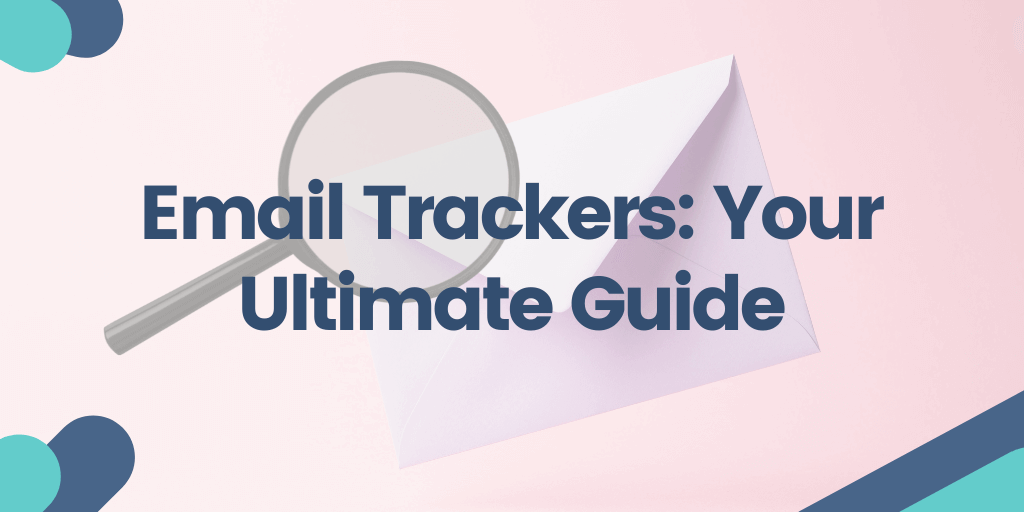Dozens of new marketing channels have developed in the past decade. So naturally, this arouses a discussion if email marketing remains a viable strategy that businesses should pursue. After all, with new social media platforms, paid ads, and influencer marketing taking center stage, has email marketing become an outdated tool for engaging your audience?
Well, the short answer is: not at all!
If you already know what is email tracking and how trackers work, jump to the list of email trackers below.
333.2 billion emails are sent and received every day in 2023. That number is set to increase to 376.4 billion daily emails by 2025. And 64% of small businesses use email marketing to reach their customers and make sales, which shows that most savvy entrepreneurs still see the immense value and ROI that email marketing can offer.
But for email marketing to live up to its reputation, it’s crucial to accurately measure how your email campaigns are performing. Whether you’re the CEO of your company, a solopreneur, a sales or support rep, or just someone who uses email as your day-to-day business communication channel, using email tracking is an integral part of understanding how you’re doing and making consistent improvements in your performance.
But what is email tracking? How should you use it? And what benefits can it offer? This ultimate guide about email trackers will aim to answer all these (and many other) questions below.
What is Email Tracking
Email tracking is the process of analyzing every part of email communications and marketing campaigns. It can help you understand what happens after your emails are sent out, providing valuable insights on how the recipients interact with your emails through data such as open rates and click-through rates.
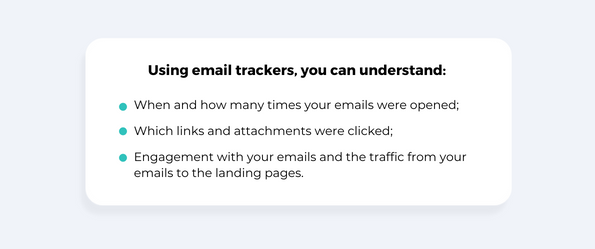
Today, businesses of all sizes can take advantage of data-based insights from email tracking, utilizing one of the many available tracking tools that can report on dates and times of events, specific email recipient behaviors, and even other data such as their location.
To better understand what is an email tracker, it’s important to clearly establish how it works. After all, the only way to make the most of the paid or free email tracker you will be using is to figure out how you could add it to your email marketing or CRM solution.

Want to display this infographic on your site?
Embed this infographic into your website pages by copying and pasting the code below:
<a href="https://mysignature.io/blog/email-trackers-your-ultimate-guide/" target="_blank" rel="noopener noreferrer"><img src="https://mysignature.io/blog/wp-content/uploads/2022/07/Frame-1.png" alt="5 Steps to choose email tracker" style="width: 100%; max-width: 1600px; max-height: 7699px;" /></a><br />Source: <a href="https://mysignature.io/blog/email-trackers-your-ultimate-guide/" target="_blank" rel="noopener noreferrer">5 Steps to choose an email tracker</a> by <a href="https://mysignature.io/" target="_blank" rel="noopener noreferrer">Mysignature</a>
How Does an Email Tracker Work?
Email tracking is based on the principle of creating a tracking pixel, which then helps to collect the analytics data about every action your email recipient takes when they receive the email. This tiny pixel image is just 1x1 pixels in size, and it’s embedded into every tracked email. When the email is opened, that pixel image is “downloaded”, which registers in the email tracker and allows you to know when and how many times the email has been opened.
This invisible image pixel allows you to detect the exact time and date that an email has been opened, allowing you to see the bigger picture of what the reader responds to and how you can cater to their needs better. You can also add redirects and special tags to the links in your email, which makes it easy to collect data about what links are clicked, how many times, and by whom.
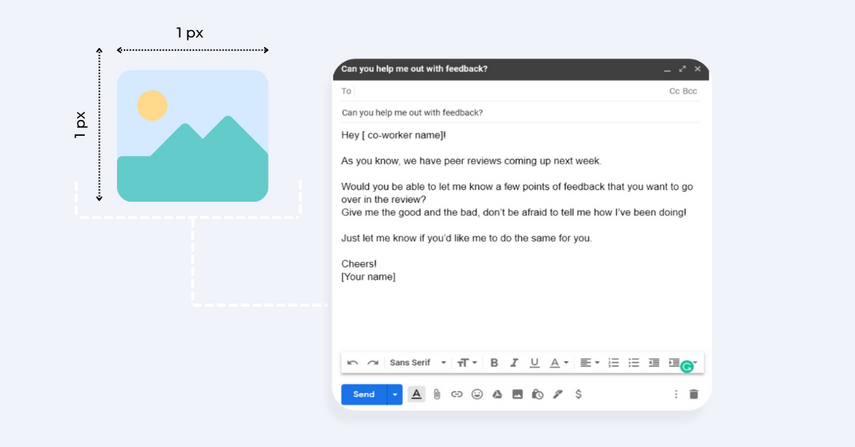
If you’re using a robust email marketing or CRM solution, it may already offer email tracking features that you can utilize. But if not, you can take advantage of free alternatives such as an email tracker Chrome extension, which is one of the best marketing tools you could employ for your business. Some of these extensions are completely free, while others have Premium or Pro plans that unlock more robust features you may decide you want.
However, no matter what type of solution you end up choosing, the fundamental principles of how an email tracker works will remain the same. And that means you don’t need the most expensive or feature-rich option to get the full benefits that collecting more information about email performance can offer.
How You Can Benefit From Email Tracking
Most business people still have a relatively limited understanding of the possibilities that email tracking can offer.
But while even a simple email tracking tool is a good start, it only scratches the surface of what email tracking can mean for your business. When used correctly, email tracking can offer a range of powerful benefits that can help you make specific and data-driven changes that have a high likelihood of improving results.
Let’s look at some of the most powerful benefits email tracking can offer you below.
Get Insights for Planning Your Next Steps
There are many ways your customer may respond to your email. Even if they don’t reply, their actions can inform you about their reactions, and knowing that information can enable you to plan your next steps with more accuracy.
When you know that an email was delivered and opened but not answered, you can think about how to better tailor the follow-up to entice the recipient to respond. Alternatively if you know they clicked through but didn’t perform the action you wanted them to (for example, didn’t purchase), you can offer a discount that provides an added incentive. There’s a virtually endless number of insights you can gain if you are able to track and analyze different actions on a more detailed level, which email tracking tools can offer.
Save Time
Sometimes, the best way to improve your email performance is to know how to prioritize. You can’t convert everyone on your prospect’s list, so you need to focus on those who are actually interested instead of beating your head against the wall with those who don’t want to hear from you.
Email tracking will allow you to see who’s reading your emails and clicking your links, which you can then use to eliminate leads that aren’t worth pursuing.

Set Up Automations
One of the best ways to scale your email efforts is to utilize automated email marketing campaigns, whether for sales outreach or when sending a recruiting email template to multiple prospects Many of the leading email tracker tools also provide you the opportunity to create follow-up campaigns based on the information you collect.
As an example, you can set up an automated follow up to go out in a few days if the recipient doesn’t open the initial email. Or, if they click through to your offer but don’t buy, you can send an automated follow-up with a discount code that can entice them to take action.
Enjoy Peace of Mind
Finally, since email communications take up such a big part of business communications, you want to be sure that the people you’re communicating with receive and go through the important information you’re sharing.
With email tracking, you can know when they open the email, whether they click on your links, and if they download the attached files that you want them to read.
Key Metrics to Measure When Tracking Emails
Knowing how your emails are performing can offer solopreneurs and businesses numerous benefits. But you can only enjoy those benefits if you know what email marketing metrics to track and how to use the data you collect effectively.
Let’s look at five of the most important email tracking metrics you should focus on below.
Open Rate
The most basic email metric you could track is the open rate. But just because it’s the most widely used doesn’t mean it’s not vital; in fact, before email providers started to preload content in emails, open rates probably provided the most value, and it remains a useful (albeit less reliable) metric you should definitely keep track of.

Knowing whether recipients are opening your emails can help you figure out whether you should continue sending emails. It can tell you how to tweak your strategy by trying new angles. Or, it can help split test subject lines to hone in on what makes your typical prospect tick.
Click Rate
Another important email metric you should track is the click-through rate. It calculates the percentage of email recipients that have clicked through to the link you shared in an email.
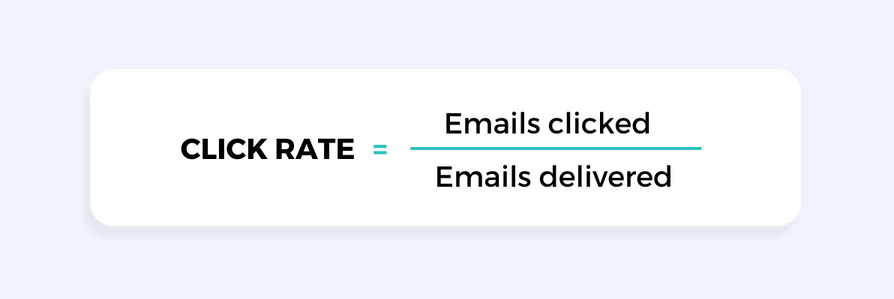
Most marketing and business emails have a goal in mind to get the recipient to take an action, such as clicking a link. Knowing whether people are clicking can tell you whether your emails are making an impact and enticing people to take action.
Bounce Rate
Email deliverability plays a vital role in the success of your campaigns. And poor deliverability will not only impact your business performance but can even get your account flagged or suspended if you persistently send emails to addresses that don’t exist.
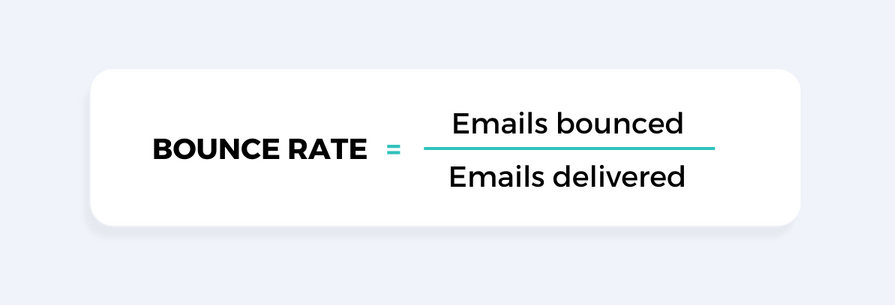
Tracking the bounce rate ensures you can quickly identify fake or inactive email addresses, while regular email verification helps to weed them out of your lists. When communicating with leads or business partners, knowing that the email is delivered will also ensure that the people you’re communicating with actually receive the information you want them to have.
Unsubscribe Rate
When sending out emails to a list, your goal is to keep them engaged and looking forward to your next communication. But to ensure that’s the case, you need to track the rate at which people are unsubscribing from your list since that’s the only way to identify what might have triggered a negative response.
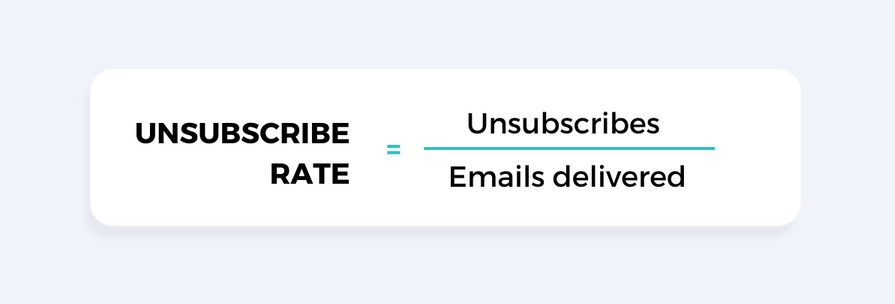
You will always have a small percentage of people regularly unsubscribe, typically something below 0.5%. But if you notice spikes after certain emails, analyze what happened and avoid making the same mistakes in the future.
Conversion Rate
In email marketing, a conversion rate measures the percentage of people who take the action you want them to take after reading the email. Usually, that will involve clicking a link, downloading an attachment, filling out a form, or even making a purchase.

This is a very impactful email metric to track because it will ultimately decide whether you reach your goal or not. After all, even an excellent open rate won’t really matter if none of the people respond to your message and perform the action you want them to take.
7 Ideas For How to Use Email Tracking
Collecting and analyzing the right metrics can allow you to make more informed decisions about every aspect of the emails you send out. But how can you make the most of the metrics we discussed in the previous section?
Let’s look at a few useful ideas for how to leverage email tracking data in your business.
Find the Best Subject Lines
Subject lines remain the most important part of any email campaign. If your email subject lines aren’t resonating with your audience, it won’t matter how good the body of the email might be, since the vast majority of your subscribers won’t even open the email to see what’s inside.
But even though they’re so important, it’s very hard to figure out what works best for your subject lines without tangible data you can rely on. Even if you utilize the email subject line best practices, they can only take you so far, as each audience is different.
The good news is that when you set up email tracking, you can know what types of subject lines grab the attention of your list. By measuring open rates, you’ll have a much better understanding of what they care about, what angles work best, and what subject lines simply don’t generate interest. Over time, you can refine your process of developing subject lines to ensure that each email generates excitement.
Discover When to Send Your Emails
Timing can play a crucial role in the success of your email campaigns. If you catch your subscribers at the wrong time, an email they would otherwise find useful might end up unnoticed or ignored because they don’t have the time or aren’t in the right frame of mind to receive it.
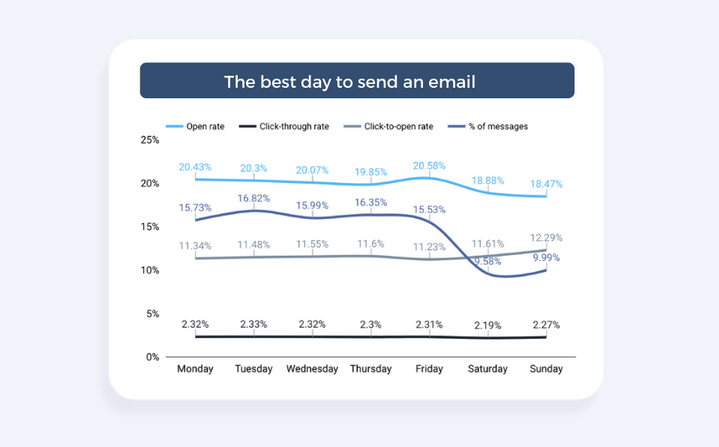
source: Getresponse
But without a way to track email performance, you have no way of knowing your audience’s preferences. And that can make you oblivious to whether the time you’re sending the emails is optimal for best results.
Meanwhile, when you utilize email tracking, you can pinpoint the best time of day (or day of the week) to send the emails, resulting in maximum engagement, responsiveness, and results for your business.
How Many People on Your List Are Actually Reading?
Having a big list is something many novice business people aspire to achieve. After all, if you have a big list, you can take in huge profits even if you have a relatively poor response, right? Well, in reality, a big list can sometimes end up being a limiting factor, especially if you don’t know how to track behaviors and tweak the messaging accordingly.
The good news is that email tracking can help you get a clear understanding of just how many people, on average, open your emails when you send them. You can experiment with different times, subject lines, and other variables to see how your email list is responding. That will show you whether your list is engaged or if you need to start filtering out the unresponsive subscribers.
Find Out If People Are Taking Action
Finally, when you have an email tracker to keep tabs on performance, you can learn how the email marketing campaign is measuring against the goals you set out. If you add links or attachments to your emails, you want to know whether people are actually clicking (or downloading) them, since that’s what will ultimately drive them to take the purchasing actions you want them to take.
Once you set up email tracking, you will quickly see the bigger trends of how your subscribers and email recipients are responding to your emails. You’ll know not only whether they open your emails but also how they’re reacting to the email body, including the CTAs and links that you want them to click.
Discover Their Location
For many businesses, one of the most valuable insights about an email subscriber is their location. Knowing the location allows companies to share more relevant offers, personalize the content to fit the offerings in the region, and ensure that the subscribers remain engaged.

source: Mixmax
And with the help of email location tracker and email address tracker tools, discovering where your subscribers live becomes an automated process that pinpoints the location of each subscriber on your list.
Send Better Follow-Ups
You can’t expect to receive a response to every email you send out. Sometimes, even the most compelling messages get lost in the inbox, are ignored, or don’t have the impact that you would like them to have.
80% of today’s prospects say no up to four times before saying yes to your offers, and that means you need to know when and how to follow up if you are going to achieve your goals.
Tracking your email open rates and conversion rates can help you figure out how the prospect is responding. And that can help determine when to send follow up emails and what messages to emphasize. If the prospect ignored your email altogether, that might mean you need to tweak the subject line. If they opened the email but didn’t click, perhaps you should try another angle. If they click but didn’t buy, throwing in a discount could get them to commit to your offer.
Test to Find the Best CTAs
Getting your email recipients to take the actions you want them to take is a big challenge. And there’s only so much you can do to improve the performance of your call-to-actions if you don’t have data that can tell you what’s working.
The good news is that this is an area where email tracking can be immensely helpful. You can try out different CTAs to get people to take action, testing various approaches until you find what works best for your audience.
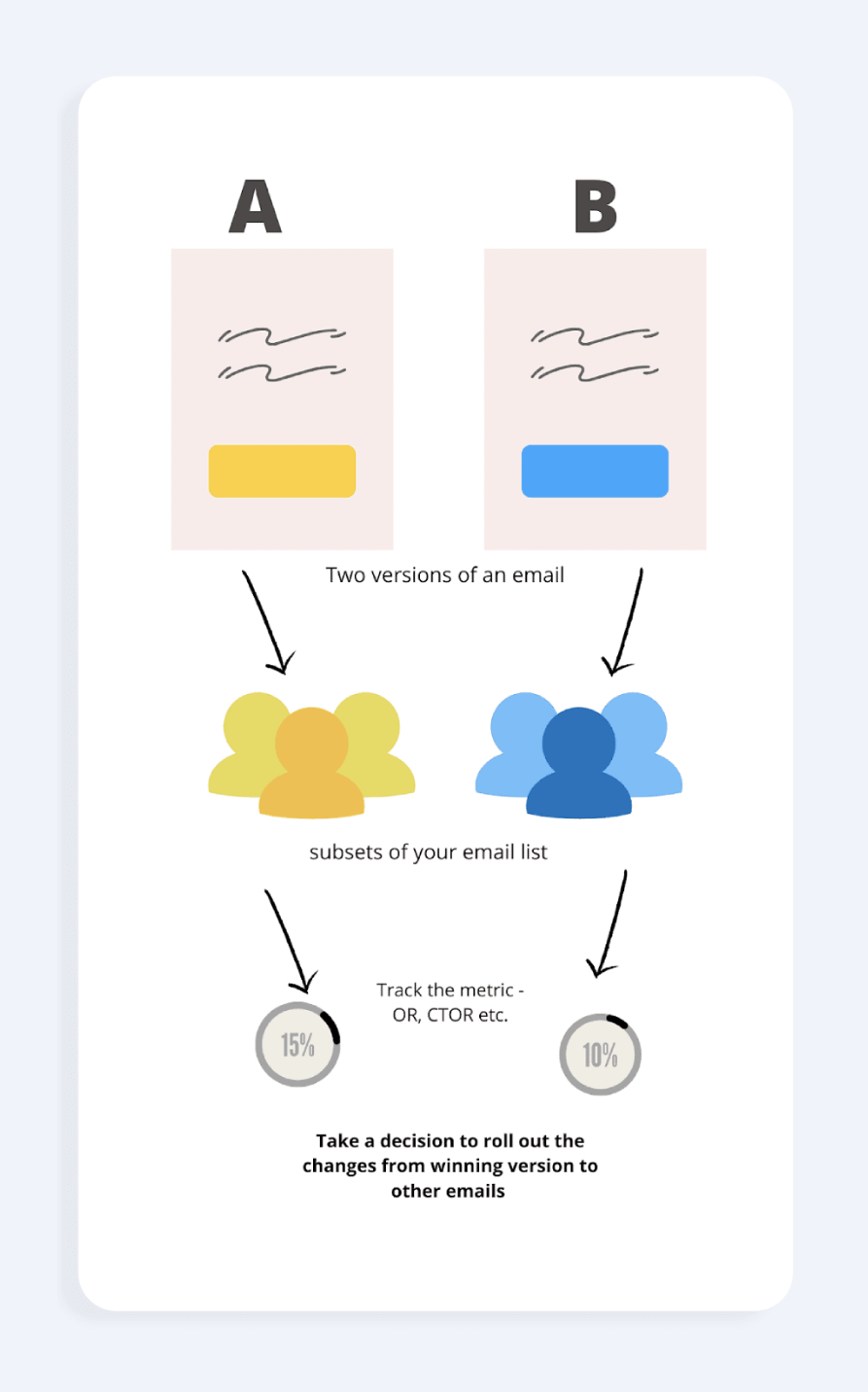
source: SendX
How to Choose the Best Email Tracking Tool
With an abundance of email tracking solutions available, you may be unsure which one you should go with. Luckily, you can quickly narrow down your choices by looking at a few key features and making sure that the email tracking software matches your current needs and infrastructure.
Let’s look at the most important aspects you should consider when choosing an email tracker, free or otherwise.
Understand Your Goals
Not all email trackers are created equal. Even though most tools provide the same basic information, each can be geared towards a different goal and target audience, which can make one tool more suitable in your situation over another.
For example, using a tool like Mailchimp or HubSpot makes the most sense for marketing emails and sending autoresponders or newsletters to a subscriber list. It’s designed to help you track the performance of your newsletters, showing you advanced analytics and allowing you to continually improve performance to get the most of your list.
For those who want to automate and improve their communication with potential clients, a tool like MIxmax makes a lot of sense because it allows you to prepare automated follow-ups based on the tracking information, segmenting email recipients based on the actions they take (or don’t take).
Finally, if you’re mainly using email for business communication and want to know what happens after you send it, you can use a tool like Mailtrack, which will provide you with convenient email tracking for Gmail that you can start using quickly and for free.
Compatibility with Your Email Client
Most businesses are already using an email client such as Gmail or Microsoft Outlook. And since you’re already set up in one of these platforms, it’s much easier to choose a compatible email tracker instead of moving to a different client just for a specific email tracking software option.
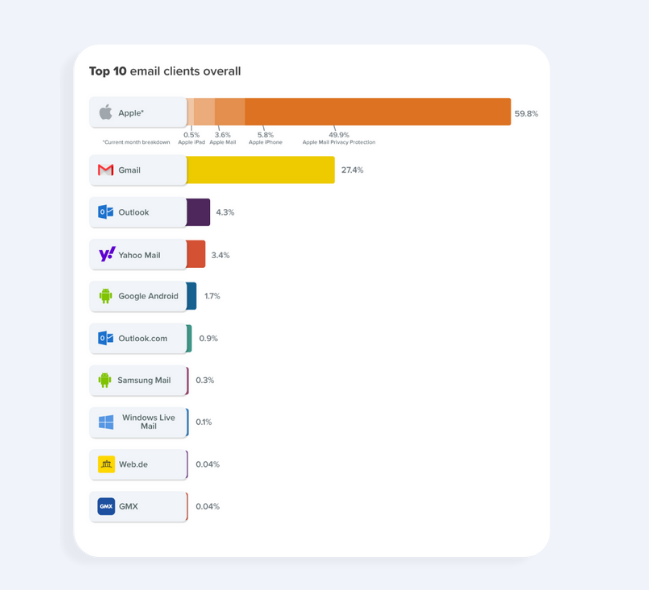
source: Litmus
Because of that, a good starting point when choosing an email tracker is to consider which one is the most compatible and easiest to use together with your current email client. If you’re using Gmail, then finding an email tracker for Gmail makes the most sense. If you have Outlook, then an email tracker for Outlook is the way to go. The same goes for Apple, Yahoo Mail, or any other client you might be using.
The good news is that some of the leading solutions are fairly versatile and offer compatible solutions for multiple email clients.
Tracked Activities
Another crucial consideration when choosing email tracking software is the activities it can track. You will need to decide whether you want to opt for simplicity and minimize the range of metrics you collect or if you want a more robust solution that provides you with a long list of data you can work with.
Some of the simpler email tracking solutions today only track the open rate of the email, which can be enough in some situations and allow you to focus on consistently improving your subject lines and timing to maximize open rates. However, this approach has its drawbacks as well.
By only collecting open rate data, you are missing out on other insightful metrics such as the number of views, time, location and device, clicks on links & attachments, individual data for emails with multiple recipients, and more. While not all of this data might be necessary, you need to evaluate each metric and decide whether it could help enhance your campaigns or if it would be a distraction. As a general rule of thumb, it’s better to focus on the most important email marketing metrics, which are the open rate, click-through rate, conversion rate, and bounce rate.
Tracking Dashboard
There are two main email tracker solutions used to collect information about the actions email recipients take. Some of them offer only real-time notifications about when your email has been opened or when the link has been clicked, while others also gather and compile statistics over time, which can help you discover the bigger picture and trends about how the recipients are engaging with your emails.
You will need to decide whether you want to track information over the long-term or just want to know immediately whether a specific email was opened, and when. If it’s the latter, then you can use one of the simple and free email tracker solutions that will give you the information about the email opens.
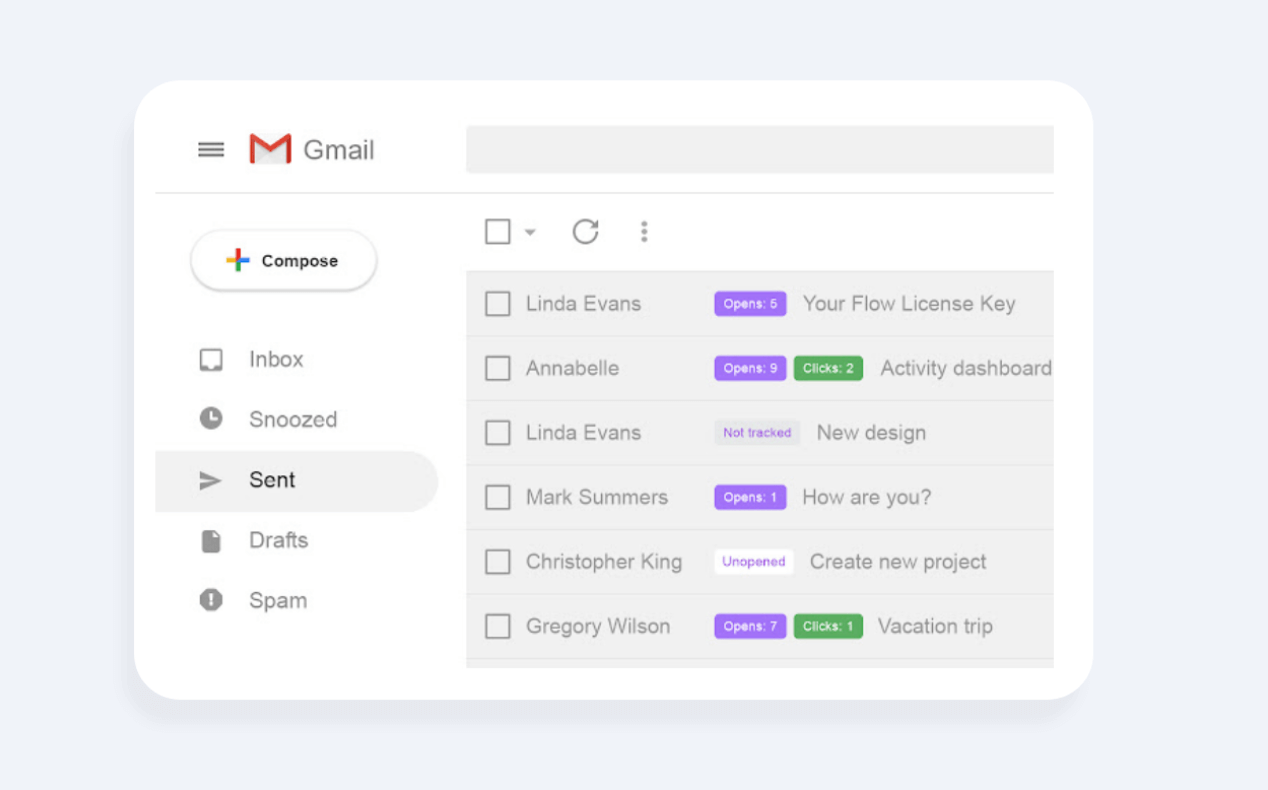
However, the long-term data about open rates, click-through rates, and other vital metrics can be immensely useful for optimizing your subject lines, CTAs, sending times, and many other variables that all have an impact on the results you can potentially achieve.
Pricing
As mentioned before, some free email tracker solutions provide you with simple functionality that might be enough to get you started. But as mentioned before, most free solutions will eventually become limiting, providing you just the immediate data and preventing you from understanding the bigger trends of how your emails are performing.
Since gaining these insights can be crucial for achieving your business goals, you should consider buying an email tracker pro version that will provide greatly expanded functionality and the ability to continually tweak and improve your emails.
Email Tracking Cons
Up until now, we’ve mainly discussed the ways you could use email tracking and what it can offer your business. But to make an informed decision about whether you should track email performance, you need to understand the disadvantages that it can come with as well.
Let’s look at some of the email tracking cons you should be aware of below.
Spam Issues
There are a few scenarios where email tracking can result in your emails being marked as spam, which can cause deliverability issues that significantly reduce your chances of success. But the good news is that you can avoid the spam folder by understanding their causes and taking appropriate steps.
For one thing, it’s important to choose email tracker software that has a good domain reputation. You want to ensure that the email tracker is trusted and used by reputable companies to avoid email service providers from marking it as spam.
You should also avoid tools that add additional redirects to your link clicks. This can sometimes be interpreted by the email providers as suspicious, resulting in the email being marked as spam as well. Instead, you should use your custom domain to act as the redirect, which reduces the chances of the email getting flagged.
Finally, if you are using shortened links in your emails, consider doing that through your own subdomain, as adding a tracker to a link shortened using a third-party tool can get the email flagged. Instead of using a service like bit.ly to shorten your links, create your own custom links through the custom domain because otherwise, the shortened link and the tracking link creates two redirects, which causes spam flags.
Email Tracking Blockers
Privacy is one of the top concerns of online users today, which is why many people are actively looking for ways to stop their emails from being tracked. Because of that, when you’re adding email trackers to your emails, you are taking a risk that your emails won’t get past the tracking blockers that people use to protect their privacy.
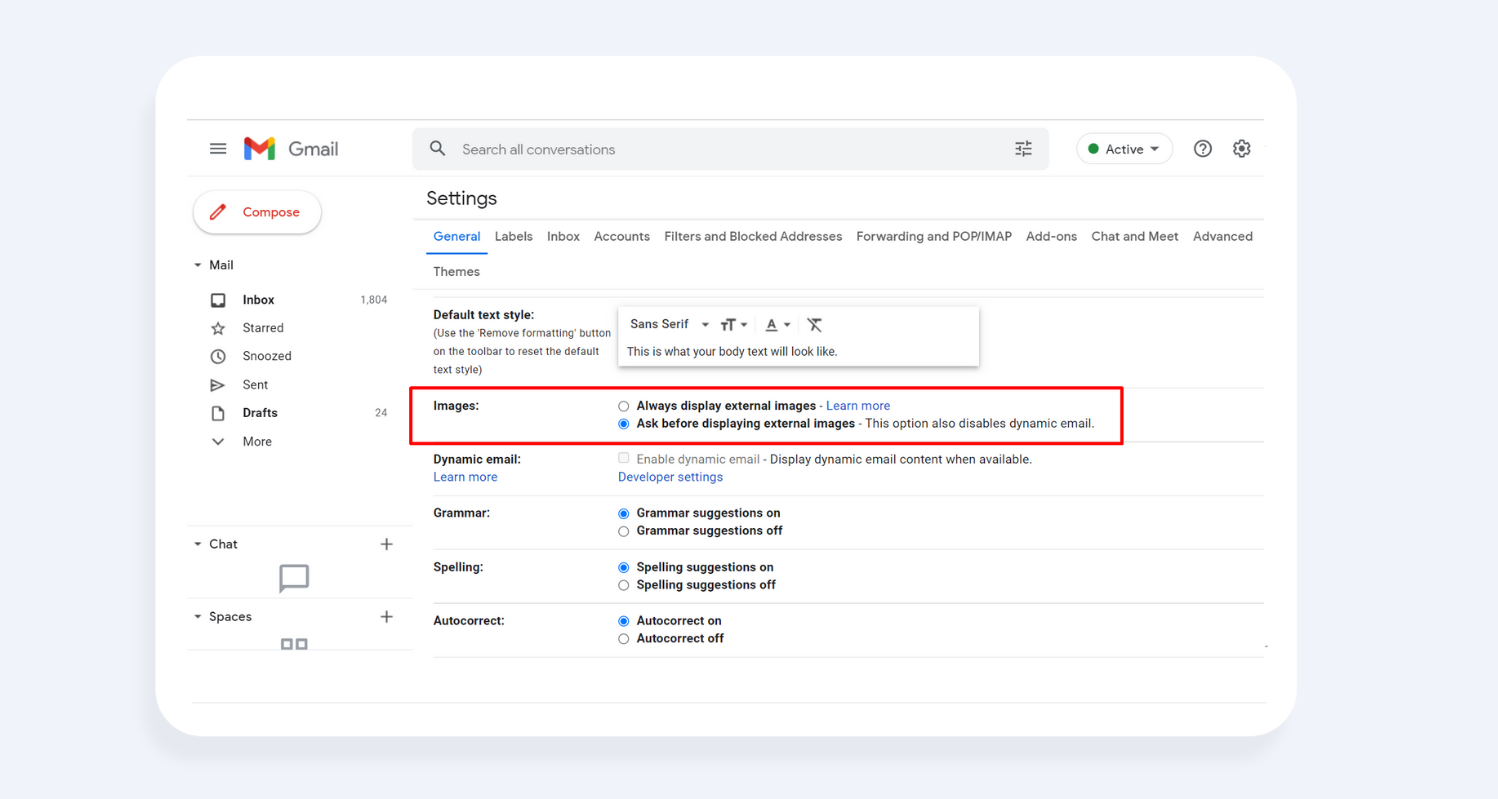
The actual method with which people protect their privacy can vary, but they usually involve stopping the pixel image from being downloaded. Users can do that manually on their email provider or use an email client like Thunderbird, which blocks the tracking images by default. There are also Chrome extensions like Pixel Block that do the same automatically.
Apple Mail Privacy Protection
When Apple launched the iOS Monterey and iOS 15, the mail privacy settings got completely revamped as well. Now, each user is prompted with a choice of whether they want Apple to hide all their private information or not, which includes the ability to track actions in an email.
When a person opts in to the “Protect Mail Activity” prompt, all future emails are routed through a proxy server, where the content is pre-loaded to catch any pixels or other tracking tools before being displayed.
Unfortunately, that means that you won’t be able to use email trackers when sending emails to people who use Apple products and have “Protect Mail Activity” set to on.
Top 10 Email Tracking Tools
Finding the right email tracking tool can be a hard task. Even if you know what you’re looking for, sorting through the dozens of options can take a lot of time and leave you unsure of how to proceed.
To help you get started, here are ten (mostly) free options you could consider.
|
MySignature provides real-time insights about openings, clicks - everything you need for personal email marketing in one service. |
Gmail |
No |
Paid plan starting at $6/month. | |
|
MailTrack is a simple yet incredibly useful tool for Gmail that will tell you whether the email has been opened and how many times. |
Gmail |
Free for basic features. |
Paid plans starting at $1/user/month. | |
|
A simple Google Chrome extension that allows you to track if an email has been opened, and when. |
Gmail |
Free |
N/A | |
|
The Snov.io email tracker allows you to track email opens and link clicks. |
Gmail |
Free |
N/A | |
|
An easy-to-use email tracking tool that can track opens and rates of your emails, completely for free and without branding. |
Gmail |
Free |
N/A | |
|
Track up to five emails per month with the free version of this tool. It will tell you when your email has been opened, how many times, and whether the links have been clicked. |
Gmail |
Has a limited free version. |
Paid plans starting at $5.95/month when paying annually. | |
|
A versatile email tracking tool that’s part of a more robust solution. Can track opens, links, replies, and even generate useful reports. |
Gmail, Outlook |
Free |
N/A | |
|
A comprehensive tool that offers basic open and click-through tracking as part of the free version. |
Gmail, Outlook |
Has a free version |
Paid versions starting at $15/user/month. | |
|
A robust email tracking solution that not only provides data but also has automated follow-up, template, and smart-reminder features. |
Gmail, G Suite |
No |
Plans starting at $5/month. | |
|
HubSpot’s email tracking tool comes with powerful features, including scheduled push notifications based on user actions and lead history. |
Gmail, G Suite, Outlook, Office 365 |
Has a free version |
Paid version for the entire HubSpot Sales Hub starts at $45/month. | |
|
A convenient Chrome extension that allows you to find out if and when your emails are opened. |
Gmail |
Has a free version that tracks opens, premium version also tracks clicks |
Paid version starts at $15/user/month. |
Do You Need Email Tracking?
Even though email tracking is primarily associated with marketers and businesses trying to make more sales, it’s actually useful in a variety of situations. It can benefit not only email marketers but almost anyone using emails for their business, as the insights offered by a paid or free email tracker can help you achieve better results with every email you send out.
Let’s look at who can benefit from email tracking below.
Email Tracking for Solopreneurs
As a solopreneur, you may be wondering whether an email tracker is really necessary. But the truth is, even if you’re a one-person business, gaining insights into the performance of your emails can be an invaluable resource that helps propel your ventures forward and improve the relationships with your customers and partners.
In fact, there are many data-backed reasons why paying attention to your email metrics is absolutely essential. For one thing, consider that the average email open rate is between 15-25%. That’s a huge number compared to Facebook, where a click-through rate is as little as 0.7%. And the email open rate can be improved even more once you start collecting data and optimizing your performance.
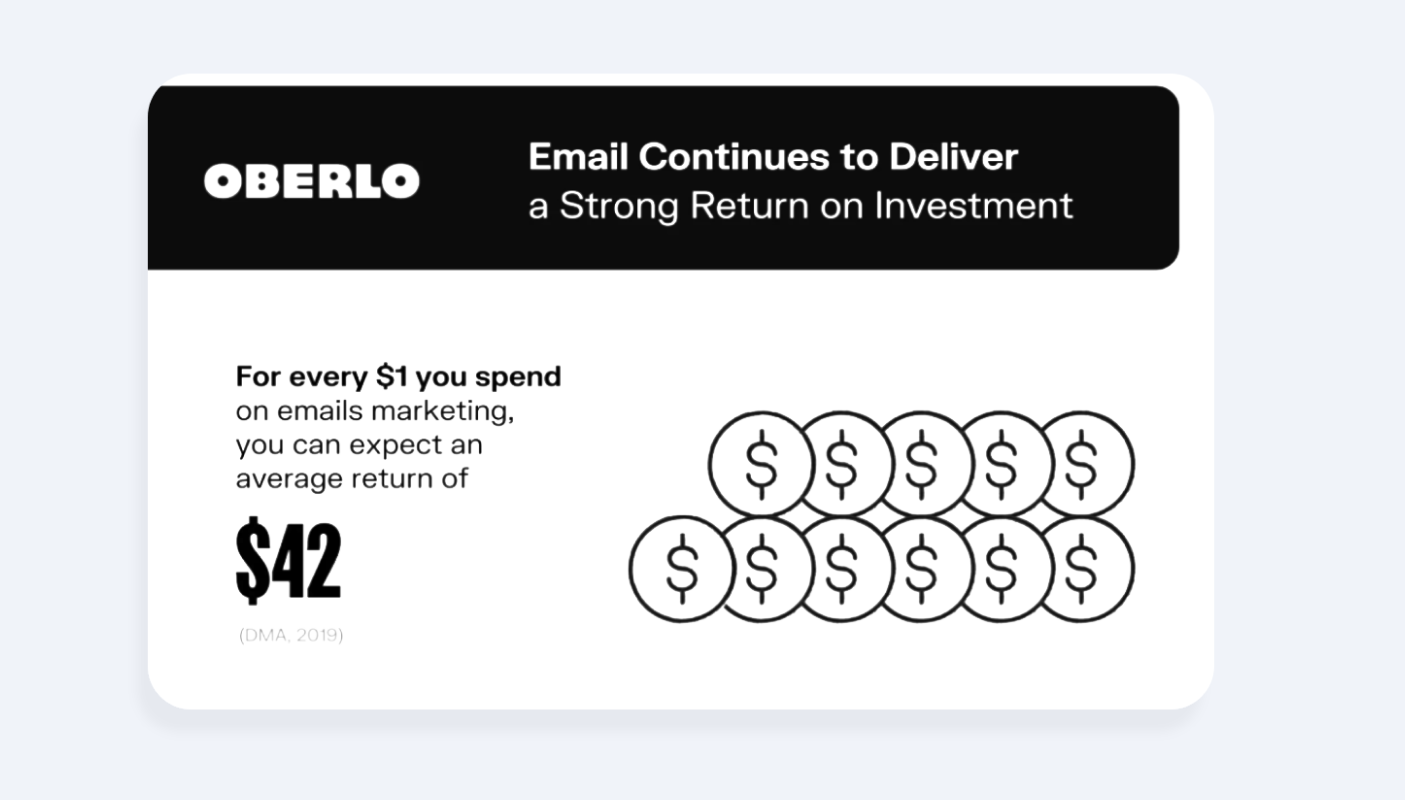
And then there’s the fact that for every $1 spent on email marketing, you can expect an average return of $42. For solopreneurs who need to maximize their budget and time, it’s hard to ignore the enormous potential that tracking emails and making consistent improvements can offer.
Email Tracking for Freelancers
If you’re a freelancer, one of the most crucial parts of your success is being able to consistently attract new high-paying clients so that you always have work to look ahead to. Unfortunately, if you leave the process to chance, it’s not always possible to maintain a steady workload, with clients sometimes disappearing faster than new ones can become available.
Luckily, email marketing is a great way to avoid that. It allows you to reach the ideal clients you want to serve and build connections that will ensure you always have new projects in the pipeline. However, for that to happen, you must have a process to track how the emails you are sending are performing.
After all, if you don’t know what happens to your emails once you send them, there’s no way to make consistent improvements. Sure, you can judge your success by the number of replies you receive, but that’s a very limited picture of what’s happening once you hit that send button.
Meanwhile, if you utilize email tracking, you can optimize every part of the emails you send, including the subject lines, CTAs, links, signature, and portfolio. That way, you’ll know that each part of your emails is working in your favor and that you’re much more likely to receive a positive response from the dream clients you are reaching out to.
Email Tracking for Recruiters
Recruiting is a fast-paced and incredibly competitive space. When hunting top talent, you are fighting against other recruiters who are just as eager. And that means you need to be able to react fast and know exactly how the person is responding to your communications.
When you utilize paid or free email tracker solutions, you can get real-time data about the actions of each candidate you’re pursuing. You can know exactly when they’re opening an email and clicking on the links you provide.
This allows you to gauge their interest, gaining a better idea of whether they are interested and whether your messages are reaching them. For instance, if you see that they’re opening your email multiple times, it’s a clear indication that they are very interested and perhaps even showing the message to their colleagues, friends, and family. That could allow you to be more aggressive in pursuing the candidate since they are clearly at least open to the idea of considering your offer.

source: Wizardsources
At the same time, you can perfectly time your responses and follow-ups according to their actions and email checking habits, maximizing the chances that you’ll get in front of other recruiters and move forward with the process of getting them on board. For example, if you notice that a candidate likes to open their emails during lunchtime, that can allow you to perfectly time your emails in the future so that they react and respond immediately.
If you want to get really creative with how you use email tracking for recruiting, you could even find out the candidate’s location and the device they’re using. Then, if you know they just opened your email on their phone, you could call them with a follow-up and keep them fully engaged with your efforts.
Email Tracking for Realtors
The realtor industry is as competitive as ever. As many as 87% of all realtors are forced to change careers within five years of starting because they simply can’t earn enough to make it worthwhile. And probably the biggest reason why this happens is the inability to 1) get enough new leads and 2) convert the leads into buying clients.
The good news is that email marketing for real estate agents can help address both of these challenges at once. If you utilize email tracker tools, the insights you gain will allow you to optimize the performance of your emails and maximize the chances of success with every person you interact with.
First off, email analytics can help you get better at reaching out to prospective clients you could work with. Email can be the perfect networking and lead generation tool, but in a world where you have to compete with other realtors, you must have a reliable process for continually improving your emails so that they get opened, read, and responded to.
With email tracking, you can optimize every part of your email, from the subject lines to the signature. You can know exactly how many people open your emails and click through to your links. Over time, this will allow you to zero in on the approaches that work best and provide you with a huge advantage over the competition.
This same principle can be applied to nurturing relationships with your current clients. You can not only improve every aspect of your emails but also get better at timing your messages in a way that improves open and response rates.
Email Tracking for Sales
Sales is a complicated and lengthy process. Countless variables can impact both individual cases and your overall sales performance, and your ability to manage those variables and tweak them in your favor will largely determine how successful your sales campaigns end up being.
And since email marketing is usually an integral part of any sales strategy, you must also have ways to track performance throughout each stage of the cycle. In fact, tracking emails can be especially useful when you’re working with leads
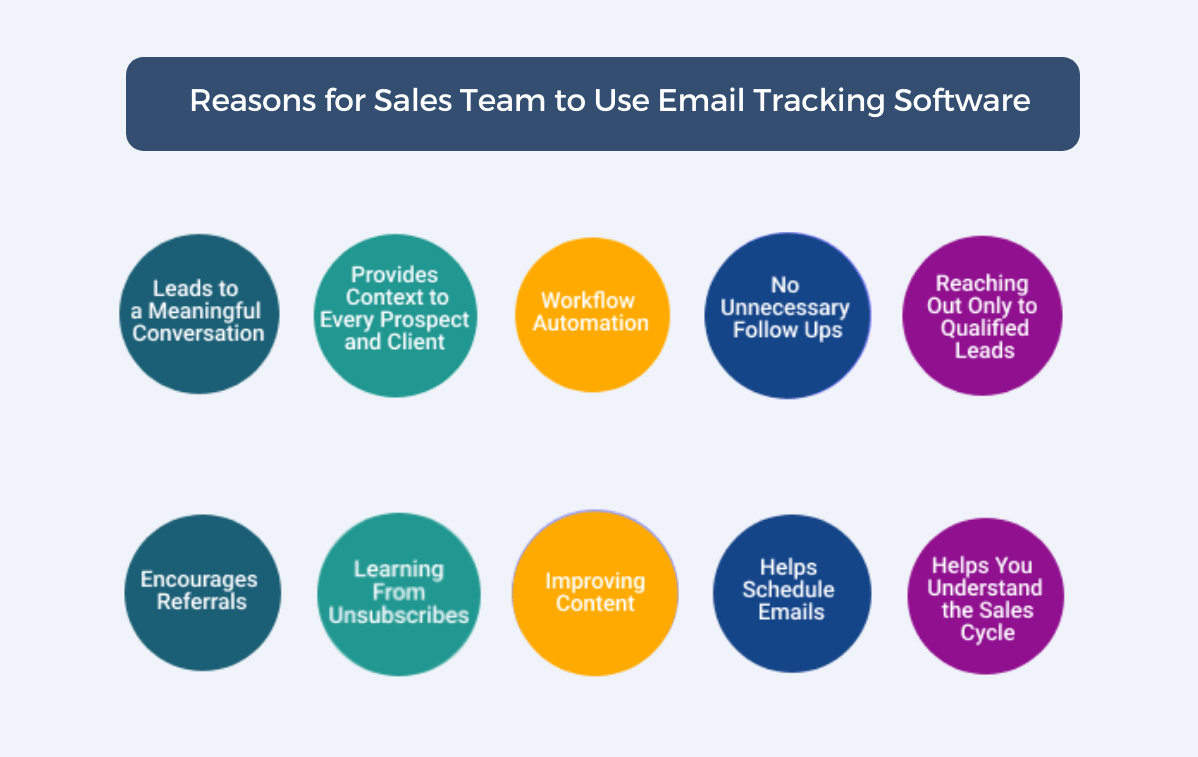
source: Openedornot
When you have a lead that you’re communicating with in the beginning stages, having an email tracking tool can allow you to accurately evaluate how much interest they have in what you offer. By tracking the open rates, click-through rates, and the number of times the email has been opened, you can gauge whether the lead is actually interested in buying and if you have chosen the right strategy for engaging them.
Another great benefit of using email tracking for sales is the ability to tailor your messages according to the stage that the lead is currently on. For example, if you know that a person opened an email and downloaded your attachment with a report or guide, you can now assume that they have more information about your product. And that means they can move on to the next stage of the sales process with additional information that they will find relevant.
Finally, when you automate parts of your email sales campaigns, tracking performance can make a massive difference in the number of sales you can make. By continually optimizing each part of every email you send out, you can find the perfect messaging for your audience and get them to open your emails and take action.
Email Tracking for Photographers
Many photographers aren’t even aware that they can utilize email marketing to attract clients. But those that understand its value can dramatically boost their growth and ensure that they never run out of new clients to work with. But for any of that to happen, it's important to have a reliable process for tracking email performance and optimizing each communication with a prospective or current client.
No matter what type of audience you might be targeting, it’s likely they have unique preferences and habits that impact how they respond to your messages. Email tracking enables you to discover these preferences and adjust the content, timing, and other aspects of your emails accordingly for maximum visibility, opens, and engagement.
If you want to target clients based on seasonal occasions such as graduations or weddings, you can run split tests on different types of emails and discover what each of those audiences likes to receive. You can customize every part of your email, down to the time of day you send them.
Today, there are many affordable email tracking solutions, so even photographers who are just getting started can take full advantage of advanced email tracking functionality that used to be reserved for large companies. And that means you can also enjoy the huge benefits of maximizing each email you send out and growing the relationships you have with your customers.
Conclusion
Email remains one of the most powerful marketing and sales tools today. But whether you want to find new clients, build stronger relationships with prospects, or even automate your sales process through email marketing, the success of your efforts will largely depend on how well you can measure performance and make data-driven improvements.
With email tracking, you can find out how many people open your emails, click through to your links, download the attachments, and engage with your messaging. And there are many paid and free email tracker solutions that provide a range of features, from simple tools that can show you whether an email has been opened to robust all-in-one solutions that provide an in-depth analysis of each email you send out.
And the right solution for you will largely depend on what type of business you are running. A sales team in a rapidly-growing company or a recruiter might want the most robust solution available, while someone like a freelance photographer could get by with a simpler option. However, having more email tracking data to work with will usually be better, no matter what type of emails you want to keep track of.
Finally, to make the most of the email tracking possibilities available today, it’s crucial to understand the underlying principles that make up good and effective emails. Being professional, understanding your audience, and utilizing the potential of sign-offs are just a few of the ways you can enhance your emails and make consistent improvements through email tracking insights.


